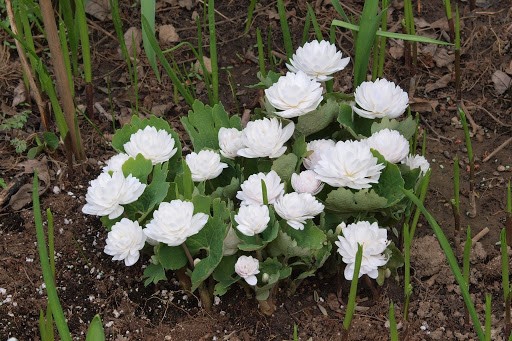by Sara Williams and Jackie Bantle
In the final part of our series on underutilized perennials, we focus on four uncommon perennials that should be more readily available to Prairie gardeners.
Bloodroot (Sanguinaria canadensis)
Native from Manitoba to Nova Scotia, both the common and the botanical names refer to the red root sap that was once used as a dye by Indigenous Peoples. If ever a flower deserved the term “ephemeral,” it is bloodroot. Once in bud, grab a cup of tea, a comfortable garden chair and a book of poetry. You have about 48 hours in which to sit and enjoy it. The flowers close at night and the petals soon fall. Nevertheless, it is breath-takingly gorgeous, especially the double form ‘Multiplex.’
The cup-shaped white flowers with orange-yellow stamens are 7 cm in diameter and held on stalks of about 10 cm. The double-flowered form lacks stamens and is longer lasting.
The basal leaves are as lovely as the flowers. Heart to kidney-shaped, lobed, and 15 to 30 cm across, they appear vertical before they unfold. By mid-summer, bloodroot has entered dormancy and disappeared.
This is a wonderful plant for a shaded border or woodland garden located in a protected location. They do best in evenly moist but well drained soil to which generous amounts of organic matter have been added.
Propagation
Bloodroot spreads slowly by rhizomes and can be propagated by careful division or by seed sown outdoors in the fall. The seed requires a cold period to ensure germination. Plants are available from NVK Connon Nurseries and Canning Perennials; both located in Ontario.
‘Goldsmith’ dwarf variegated comfrey (Symphtum hybrid of unknown origin often sold as Symphytum grandiflorum ‘Variegatum’or S. ibericum ‘Jubilee’)
Here is a beautiful and well-behaved selection of comfrey that belies the reputation of the better known but wildly aggressive, rampant and invasive species. Once reputed to heal wounds, the common name, comfrey, is from the Middle English word cumfrie and the Old French fegier, meaning to cause coagulation of wounds. ‘Goldsmith’ is a variegated hybrid of unknown parentage.
It forms a low clump of light green variegated leaves about 30 cm in height. Red buds mature to soft blue, bell-like flowers in drooping clusters from late spring to early summer. It has a rhizomatous rootstock.
‘Goldsmith’ is ideal for a shaded border or woodland garden. Remove any portions that revert to green.
Propagation
It is propagated by division or root or stem cuttings. Plants are available from NVK nursery.
‘The Beatles’ (Carex caryphyllea) is an ornamental grass. Its appearance is reminiscent of the haircuts sported by the famous British band; cute, slightly curly mop-head. The short runners gradually form a colony of narrow green foliage about 20 cm in height. This is a well-behaved, hardy and very adaptable grass that will do well in sun or shade on a variety of soils. It is very drought-tolerant once established. It should be much more readily available.
Propagation:
‘The Beatles’ spreads by division. Unfortunately, we were unable to find any nursery carrying this plant. If you have more luck than we do, please let us know.
Giant white fleece flower (Persicaria polymorpha)
The giant white fleece flower was introduced to North American horticulture by Wolfgang Oehme, a German landscape architect who gained fame for his promotion of ornamental grasses. This is indeed a giant of a perennial, but it is exceedingly well behaved and non-spreading. Native to the high elevation, gravelly slopes of China and Japan, it is the one that visitors always ask about.
Forming large, vase-shaped clumps, the giant white fleece flower produces enormous, fluffy spikes of creamy white flowers in July on stems 200 cm and higher! By September the flowers have muted to a soft tan. The large, pointed, green leaves compliment the flowers.
It will thrive in sun or shade in a variety of soils from dry to moist. It is extremely drought-tolerant once established. Use this as a specimen plant or at the back of a border.
Propagation:
Plants are available from Vesey’s Seeds in PEI and Paramount Nursery in Ottawa, Ontario.
Good luck with your perennial shopping. Happy Gardening!
This column is provided courtesy of the Saskatchewan Perennial Society (SPS; saskperennial@hotmail.com ). Check our website saskperennial.ca) or Facebook page (facebook.com/saskperennial). All Saskatchewan Perennial Society events are on hold until further notice.


